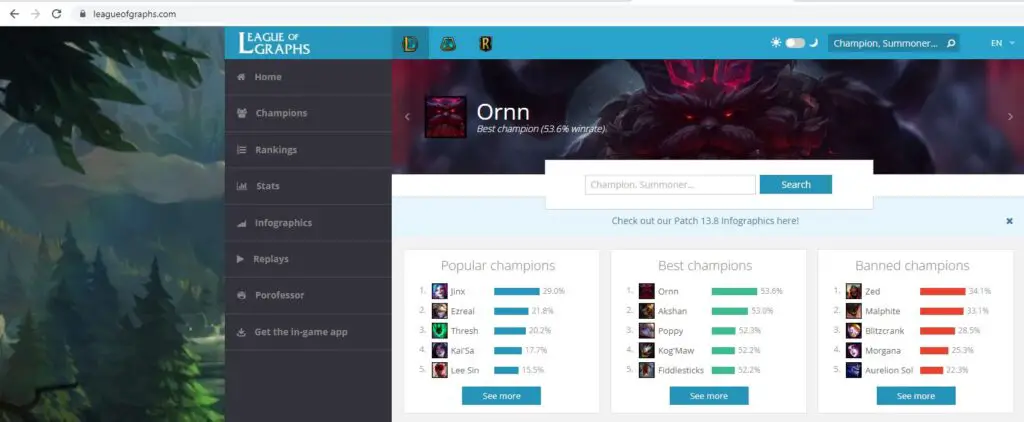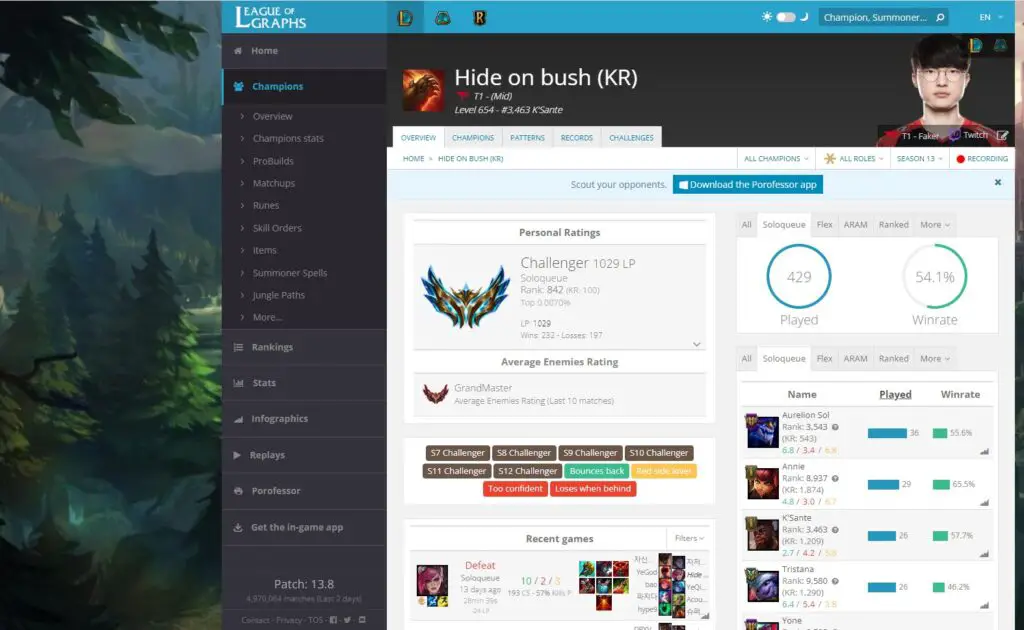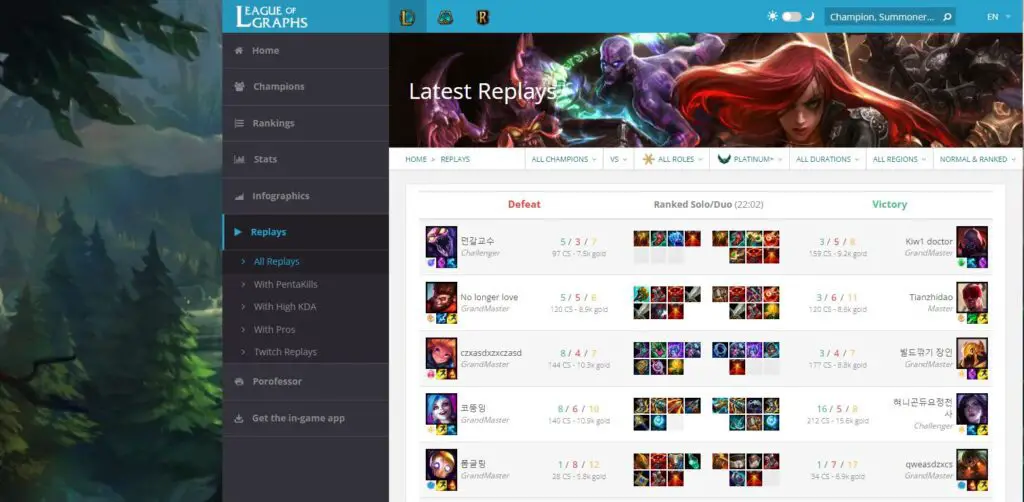

Introduction
If you’re a dedicated League of Legends player looking to up your game, then look no further than League of Graphs. This powerful platform offers detailed insights into the game, helping you track your progress, scout your opponents, and stay ahead of the competition. In this comprehensive guide, we’ll take you through the features and tools available on League of Graphs, so you can maximize your potential and climb the ranks like a true Challenger.
Creating an Account
First things first, you’ll need to create an account on the League of Graphs website. It’s a simple process: just click on “Sign Up” in the top right corner and follow the on-screen instructions. Having an account allows you to save your preferences, access personalized data, and enjoy a more tailored experience.
The Dashboard
Overview – Expert Insight
As an experienced League of Legends player, the Overview section is my starting point for understanding my recent performance in the game. This section provides a concise summary of my current rank, win rate, and most played champions, along with other key metrics that help me gauge my progress. I often use this section to identify trends in my performance, such as whether I am on a winning or losing streak, and to determine which areas I need to focus on improving. By having a clear overview of my recent gameplay, I can make informed decisions about my next steps to achieve my goals.
Champions – In-Depth Analysis
When I want to delve deeper into my performance with specific champions, the Champions section is my go-to resource. This section breaks down my win rate, KDA, and other vital stats for every champion I have played recently. I use this information to identify which champions I excel at and which ones require more practice. Additionally, by analyzing my stats with different champions, I can decide which ones to prioritize in my champion pool based on my strengths and the current meta. This helps me make strategic decisions in champion select and increases my chances of winning games.
Statistics – Fine-Tuning Your Skills
The Statistics section is where I turn when I want a comprehensive analysis of my gameplay. This section provides an extensive array of data, such as my CS per minute, gold earned, wards placed, and other essential metrics. As an expert player, I understand the importance of these statistics in determining my overall performance. By carefully examining these metrics, I can pinpoint specific areas of my gameplay that need improvement and make data-driven adjustments to my strategy. For example, if I notice that my vision score is consistently lower than my peers’, I can work on improving my ward placement and map awareness to boost my overall performance.
Match History – Learning from the Past
Reviewing my Match History has proven to be a crucial part of my journey towards becoming a better player. This section displays all my recent games, including my performance in each match, making it easy for me to identify patterns and trends in my gameplay. I use this feature to analyze both my victories and defeats, understanding what worked well and what didn’t. By examining my match history, I can learn from my mistakes, celebrate my successes, and adapt my strategies for future games. This process of reflection and adaptation is what sets expert players apart from the rest, and Match History is an indispensable tool for facilitating that growth.
Summoner Search – Scouting the Pros


As an expert League of Legends player, I know the value of learning from the best. The Summoner Search feature on League of Graphs allows me to gain insights into the gameplay of professional players like Faker, widely considered one of the greatest players of all time. By studying his performance, champion pool, and overall progress, I can improve my own gameplay and learn valuable strategies.
To begin, I would search for “Faker” in the Summoner Search bar. Upon finding his profile, I would first analyze his most played champions, noting his win rates and KDA ratios with each. This information is invaluable for understanding which champions he excels with and why. By examining Faker’s champion pool, I can learn about the meta, identify strong champion picks, and discover new strategies that I can incorporate into my own gameplay.
Next, I would dive into his match history, paying particular attention to his recent games. By examining the details of each match, such as his item builds, rune choices, and skill order, I can better understand how he adapts his gameplay to different situations and opponents. This knowledge allows me to make more informed decisions in my own games and to anticipate the strategies employed by other high-level players.
In addition to studying his match history, I would also pay close attention to Faker’s overall performance metrics, such as his average CS per minute, gold earned, and vision score. By comparing these statistics to my own, I can identify areas where I need to improve and set specific goals to work towards.
Finally, I would explore any available replays of Faker’s games. Watching these replays enables me to observe his decision-making, positioning, and mechanics in real-time, providing a unique opportunity to learn from one of the best players in the world. By studying his gameplay, I can gain insights into the thought processes and strategies that contribute to his success, and apply these lessons to my own journey towards becoming a better player.
Leaderboards – Global and Regional Insights
As an expert League of Legends player, I recognize the importance of staying informed about the top players both globally and within my region. The Leaderboards on League of Graphs provide a comprehensive overview of the highest-ranking players, their champion pools, and performance statistics. By analyzing this information, I can learn from the best, stay updated on the current meta, and adapt my strategies to climb the ranks more effectively.
Global Leaderboards
The Global Leaderboards are where I go to gain insights into the top players worldwide. By examining the profiles of these elite players, I can observe their most played champions, win rates, and overall performance metrics. This information allows me to identify trends in the global meta, discover strong champion picks, and learn about innovative strategies employed by the world’s best players.
When I study the Global Leaderboards, I pay close attention to the champion pool diversity and playstyles of the top players. By comparing these aspects to my own gameplay, I can identify potential areas for improvement and consider expanding my champion pool or refining my playstyle to better align with the most successful players. This continuous learning process is crucial for climbing the ranks and staying ahead of the competition.
Regional Leaderboards
While the Global Leaderboards provide valuable insights into the overall state of the game, the Regional Leaderboards offer a more focused perspective on the top players within my specific region. This information is particularly useful for understanding the nuances of my region’s meta and identifying strong picks or strategies that may be more effective in my local games.
As an expert player, I use the Regional Leaderboards to monitor my own progress and set achievable goals for my climb. By comparing my performance to the top players in my region, I can set realistic benchmarks and work towards closing the gap between us. Additionally, I often scout the profiles of my regional competition to better understand their champion pools and playstyles, which helps me prepare for potential matchups and make informed decisions during champion select.
Champion Statistics – Informed Decision-Making for Climbing
As an expert League of Legends player, I understand the significance of making informed decisions when it comes to champion selection and overall gameplay. The Champion Statistics provided by League of Graphs, such as win rates, popularity, KDA ratios, and ban rates, offer valuable insights that can help me optimize my strategies and climb the ranks more effectively.
Win Rates
Win rates are a critical metric that I consider when assessing the overall strength of a champion in the current meta. By examining the win rates for each champion, I can identify strong picks that are likely to help me secure victories in my games. Additionally, I use this information to adapt my champion pool, focusing on champions with high win rates while avoiding those with low win rates that may be underperforming in the current meta.
Popularity
Popularity provides insights into how frequently each champion is played by the player base. I use this data to anticipate which champions I might encounter in my games, preparing myself for the most common matchups. Moreover, the popularity metric helps me find niche picks that are less frequently played, allowing me to catch my opponents off guard with unexpected champion selections and strategies.
KDA Ratios
KDA (Kills, Deaths, Assists) ratios are an essential tool for evaluating a champion’s overall performance. By studying the KDA ratios for each champion, I can gain insights into which champions excel at securing kills and assists while minimizing deaths. This information is crucial for identifying champions that are likely to perform well in my games and for understanding my strengths and weaknesses when playing different champions. By focusing on champions with high KDA ratios, I can optimize my gameplay and increase my chances of success.
Ban Rates
Ban rates play a significant role in my preparation for champion select. By knowing the ban rates for each champion, I can make strategic decisions about which champions to prioritize in bans or learn as potential counters. This data helps me identify champions that are frequently banned, allowing me to adapt my champion pool accordingly and ensure that I have viable alternatives in case my preferred picks are banned.
Live Game Analysis
The Live Game analysis feature is invaluable for gaining real-time insights into my ongoing matches. I use this tool to assess my teammates and opponents, their champion picks, and their current performance. This information helps me make strategic decisions during the game, such as which lanes to prioritize and which objectives to contest. Additionally, the Live Game analysis feature assists me in identifying potential threats and opportunities, allowing me to adapt my gameplay accordingly.
Replays


Replays are a crucial resource for learning from both my victories and defeats. By reviewing my past games, I can identify patterns in my gameplay, discover areas that need improvement, and recognize successful strategies that I can continue to implement. Studying replays also enables me to learn from my mistakes and pinpoint specific moments that influenced the outcome of the game. This process of reflection and adaptation is essential for continuous growth as a player.
Guides and Builds
League of Graphs offers a wealth of community-created guides and builds, which I use to expand my knowledge and stay up-to-date with the latest strategies and champion optimizations. By studying these resources, I can discover new tips, tricks, and strategies that I may not have considered before. Additionally, I can learn from other experienced players’ perspectives, enabling me to refine my gameplay and make more informed decisions during my matches.
In-Depth Analysis
The platform’s in-depth analysis features provide me with comprehensive data on my gameplay, such as CS per minute, vision score, and other essential metrics. I use this information to pinpoint specific aspects of my gameplay that require improvement and set measurable goals for my progress. By continually monitoring my performance and making data-driven adjustments to my strategies, I can optimize my gameplay and climb the ranks more effectively.
API Access
API access allows me to integrate League of Graphs data into my own applications or custom tools, providing me with even more opportunities to analyze and improve my gameplay. By leveraging this feature, I can create personalized solutions tailored to my specific needs and goals as a player, enhancing my growth and development.
Mobile App
The League of Graphs mobile app ensures that I have access to all the platform’s features and data while on the go. By using the app, I can easily review my performance, study guides and builds, and stay informed about my progress, even when I’m away from my computer.
Conclusion
League of Graphs is an invaluable tool for any League of Legends player looking to improve their gameplay and climb the ranks. With its wealth of data, analysis tools, and resources, it offers everything you need to optimize your performance and become a true Challenger.
FAQs
- Is League of Graphs free to use? Yes, League of Graphs offers many features for free, but some advanced features require a premium subscription.
- Can I use League of Graphs on mobile devices? Yes, League of Graphs has a mobile app, allowing you to access your data and insights on the go.
- Does League of Graphs only support ranked games? No, League of Graphs supports data from ranked, normal, ARAM, and other game modes, providing a comprehensive overview of your performance.
- Can I use League of Graphs to track my friends’ progress? Yes, you can use the Summoner Search feature to look up your friends and monitor their performance, champion pool, and overall progress.
- How can I contribute to guides and builds on League of Graphs? Registered users can create and submit their own guides and builds, sharing their knowledge and expertise with the community.
